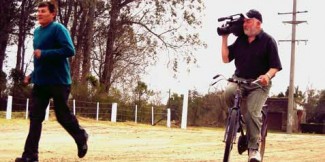The Peddler (Eduardo de la Serna, Lucas Marcheggiano, Adriana Yurchvitch, 2010): Argentina
Reviewed by Richard Feilden. Viewed at the Regal Cinemas, Los Angeles Film Festival.
Daniel Burmeister likes his cinema social, but he’s doing a lot more than just whine about people abandoning theaters for their TVs, laptops and cell phones. In their documentary The Peddler (El Ambulante), Eduardo de la Serna, Lucas Marcheggiano and Adriana Yurchvitch tell the story of a man who has made it his mission to take film back to the people.
Burmeister has taken cinema out on the open road and into the lives of small towns and villages in Argentina. Nothing too odd there, except that he isn’t just showing films on a sheet taped to the wall of a tiny church, he’s making them as he goes. With a camera in his hand and a hole in his car radiator, he asks only for food and lodging, and in exchange he turns the locals into movie stars. On a budget of whatever he can scrounge (who needs a dolly and tracks when you can be dragged across the floor on a tarpaulin?), and pulling from his grab-bag of half a dozen scripts, he finds a role for everyone who wants to take part, and a solution to every problem that he encounters. From girlfriends who won’t let their significant other ‘marry’ another woman in a wedding scene, to losing his leading man for the afternoon when he is called upon to use his taxi as a hearse, no hurdle is insurmountable for this film-making titan.
What we get then is a ‘behind the scenes’ view of Burmeister’s method. From his inclusive casting session, to the premiere of his latest work, the film covers the process from start to finish. It is at its best when the crew captures the action live and unfiltered. These scenes, which are in the majority, are filled with Burmeister’s infectious passion, and the direct cinema style – those being filmed are more concerned with their performance for Burmesiter’s camera than that of the documentarians – allows this to shine through. However, a few scenes at the start have obviously been recreated for the film. These scenes, ironically those in which the mayor’s office agrees to support his work, are so stilted and awkward that they threaten to kill the film before it gets off the ground. Stick with it though, things quickly improve.
What quickly becomes clear is the impact that Burmeister has on those that he drags into his endeavor. This is the true power of Burmeister’s work. As one astute villager notes, Burmeister brings people together. Near strangers become co-stars and suddenly everyone is talking to everyone about the film. A collective memory is formed, its touchstone immortalized on the DVDs he sells to keep his equipment and car running. Nothing like this has happened before to these people (lets be honest, outside of the sixty or so villages that Burmeister has worked with, to any people), and it never will again.
And so our audience was brought together as we watched this small documentary about even smaller films, sharing laughter, cheers, and perhaps even a little jealousy. None of us may ever have the chance to take part in one of Burmeister’s works, but if you’re lucky you might have a chance to see his story. Do yourself a favor though – watch it with as many friends, old and new, as possible.
About this entry
You’re currently reading “The Peddler (Eduardo de la Serna, Lucas Marcheggiano, Adriana Yurchvitch, 2010): Argentina,” an entry on Student Film Reviews
- Published:
- 06.30.10 / 9am
- Category:
- Documentary, Films, Los Angeles Film Festival 2010

No comments
Jump to comment form | comments rss [?] | trackback uri [?]